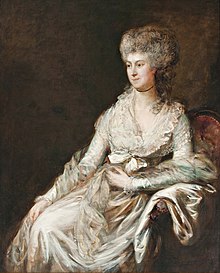Francesca Lebrun
Francesca Lebrun
| |
|---|---|
 Francesca Lebrun, in the collection of the Art Gallery of South Australia | |
| Background information | |
| Birth name | Franziska Dorothea Danzi |
| Born | 24 March 1756 Mannheim, Electoral Palatinate, Holy Roman Empire |
| Died | 14 May 1791 (aged 35) |
| Occupation(s) | Singer and composer |
| Instrument(s) | Keyboard |
Francesca Lebrun (
Early life
She was born Franziska Dorothea Danzi in Mannheim, Electoral Palatinate (present-day Germany), the eldest child of Italian-born cellist Innocenz Danzi and dancer Barbara Sidonia Margaretha Toeschi, the core of the elite elector Mannheim court performers in the late 1750s. Her two brothers, the cellist Franz Ignaz (1763–1826) and the violinist Johann Baptist, were successful composers. The violinist, composer and conductor Karl Joseph (Carlo Giuseppe) Toeschi was her maternal uncle.
Career
She made her first public appearance as a singer at the age of 16 and the following year was engaged by the Mannheim Opera. There seems to be some debate whether she first performed in
In 1778, she married the
A celebrated coloratura soprano, she sang on major operatic and concert stages through Europe, including England, Germany and Italy, to great acclaim. The musician and writer C.F.D.
Family
Francesca's family flourished as well, she gave birth to her daughter
Her daughters also became well-known. Rosine Lebrun (1783–1855) was a successful opera singer and actress and was a member of the Munich theatre company, 1801–1830. Sophie [Dülken] (1781–1863) became a well-known pianist and composer, and her daughters and granddaughters also became musicians.
Discography
- Six Sonatas for Fortepiano and Violin, Op. 1. Monica Jakuc (piano), Dana Maiben (violin). Dorian Discovery, 1996.
- Sonata for Piano and Violin, Op. 1, no 2, in E-flat Major. Jaroslav Sveceny (violin), Fine Zimmermann (harpsichord). Women Composers at the Courts Of Europe (Cybele Records, 2000). Both available at CD Universe.
- Sonata for Violin and Piano, op. 1, no. 6 in D Major; Aleksandra Maslovaric (violin), Tania Fleischer (piano). Feminae in Musica, Feminae Records 2007. Available at Arkiv Music.
References
- ^ New editions have been published of both op. 1 (New York: Da Capo Press, 1990) and op. 2 (Fayetteville, AR: ClarNan Editions, 2003).
